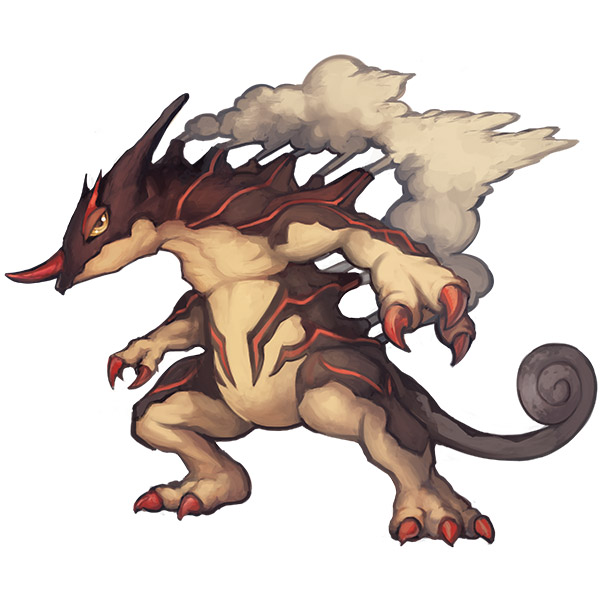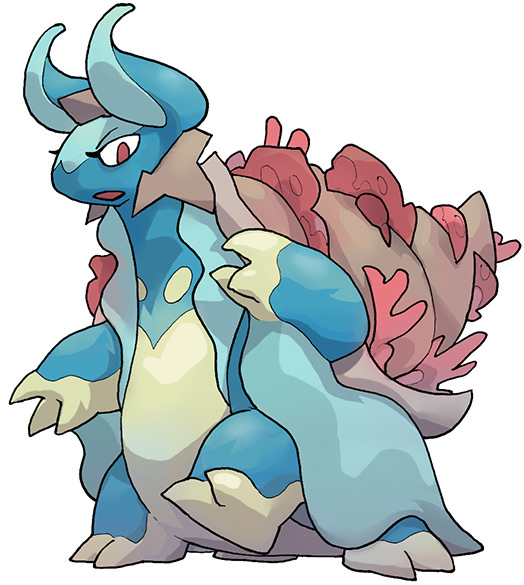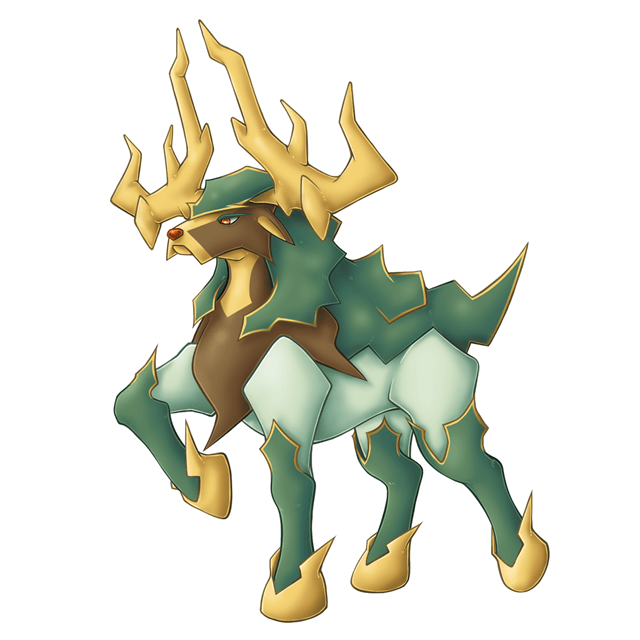ReCAP 25
| « Previous Article | Next Article » |
Introduction
With its silver anniversary, CAP decided to celebrate through changes to the 25th CAP Process. Through a lengthy Policy Review discussion, a system of "Frameworks" was decided on to break some of the rules that CAP usually so rigidly follows. Custom elements were again on the table, which previously stopped as CAP moved to Generation 5. Up to two stages of the competitive process could be influenced, changed, and modified greatly, with submissions like "255 Speed," forcing stats to adjust and reverberating throughout the whole process, and "Gourgeist Formes," which would have forced a number of additional sets of stats to replicate the size-change mechanic. After the polls, CAP found itself facing a challenge like no other in its history: a trio of starter CAPs, limiting typing to the Fire, Water, and Grass trio and stats to a limited base stat total. With an unprecedented tripling of the workload ahead, Concept submissions led to the choosing of "Astounding Ability Actualization;" aiming the process towards maximizing the potential of an ability through synergy with a movepool. During Concept Assessment, each of the three types were given an archetype or role to work towards, and the meat of the process began.
CAP25F - Smokomodo

25F's winning design by Yilx.
CAP 25F was intended to be offensive, given its forced Fire typing and Fire-type's difficulty to be anything but offensively oriented, and further defined as a wallbreaker. Through the Typing stage, several secondary typings were proposed to benefit that approach, including Ground, Ice, Electric, and Psychic, that all had obvious synergy with abilities and good coverage with Fire. In the end, it was the powerful, almost totally unresisted neutral coverage that Fire / Ground gave that won over the voters, and the process moved towards a difficult Ability discussion. The nature of building such an offensive Pokémon gave the community a great deal of ideas, be they critical hit-related abilities like Super Luck, Sniper, and Merciless, strict damage-boosting abilities like Sheer Force and Technician, or more unique ones like Multiscale to enable other elements of an offensive movepool. An important note was the general power level of these suggestions: several popular ideas including Merciless and the runner-up Sheer Force started a trend in the Fire starter's discussions throughout with expectations of a very high power level being evident. Technician's numerous possible moves, both STAB and coverage, drew the eyes of the community, as it won the final poll. During the Stats stage, the discussion shifted a slight bit: where earlier discussion had assumed a slower, bulkier wallbreaker type of offense, the stat limits and eventual stat spreads submitted trended faster and frailer, changing the direction of the discussion around it.
There were two major debates in Moveset Discussion, beginning with what appeared as a logical addition of Flame Charge. In an argument that took several days, detractors of the move highlighted the difficulty offensive teams would face against Smokomodo's boosted base 97 Speed tier, whereas supporters argued that the metagame would adapt around it and things like faster Choice Scarf users and priority would arise. This discussion is pointed to as the highlight of the whole CAP 25 process, with both sides of the argument making excellent points and comparisons, all relating to the matchup against offensive teams. Priority calcs were discussed both in favor of and against Flame Charge, the effect of the free, Technician-boosted chip from clicking Flame Charge was evaluated, and finally it was decided to have too negative of an effect on offense in the metagame and was removed. The second was over the incredible power of Technician-boosted Bonemerang, which hits a whopping 150 Base Power before STAB. Proponents of Bonemerang argued it was necessary to maintain a wallbreaker-like role, though it heavily limited defensive switch ins. Both moves were victims of the banhammer, amid discussion on coverage moves like Bullet Seed, as other moves such as Bone Rush, Bulldoze and Flame Wheel took center stage in the final movepool, alongside non-STAB Technician options like Mach Punch and Bullet Punch. At its final product, the flaming volcano lizard Smokomodo stands as a much-disputed and debated future CAPmon, the most of all three CAP 25 starters: some find it a strong fit into the metagame, synergizing well with metagame trends such as the rise of popularity of Pursuit users like Weavile , but others struggle to find use with what appears as an underwhelming stat line and a movepool deemed too shallow.
Hot Sets
- HP88
- ATK116
- DEF67
- SPA88
- SPD78
- SPE97
- Smokomodo @ Metronome / Groundium Z
- Ability: Blaze
- EVs: 252 Atk / 4 Def / 252 Spe
- Jolly Nature
- - Flare Blitz
- - Earthquake
- - Taunt
- - Morning Sun
This set aims to take advantage of Smokomodo's hard-hitting STAB combination in order to break through common defensive cores in the CAP Metagame. Flare Blitz is the Fire STAB attack of choice, with the recoil damage easily worth the damage it deals. STAB Earthquake, boosted by Metronome, improves the matchup against walls like Arghonaut and Clefable. Taunt helps Smokomodo stop its defensive answers from using status moves, further improving the matchup against defensive teams. Morning Sun gives reliable recovery, which Smokomodo can use to stay healthy on predicted switches. Metronome gives a progressive boost of power to both Flare Blitz and Earthquake when used repeatedly, giving Smokomodo the ability to force out Pokémon that may be able to stomach multiple hits otherwise. Alternatively, Groundium Z enables a powerful Tectonic Rage for a Ground-type nuke to threaten neutral switch-ins.
Smokomodo pairs extremely well with Weavile as an offensive core built around letting Smokomodo clean teams late-game. Weavile matches up very favorably against the majority of Smokomodo's popular checks, being able to Pursuit trap the Lati twins and threats like Pajantom, remove Tomohawk with Icicle Crash, and threaten other switch-ins like Chansey and Rotom-W with Knock Off. Smokomodo invites these checks in, allowing it to double out to Weavile for damage and momentum. With checks removed, Smokomodo can clean and pressure teams reliant on defensive answers easily and effectively.
CAP25W - Snaelstrom

25W's winning design by Pipotchi.
CAP 25W's role was decided to be defensive, putting it in stiff competition with other bulky Waters like Toxapex and Arghonaut from the get-go, forcing the community to separate it from the pack. Typings suggested in the Typing stage ranged from Water / Poison, aiming for a more offensive variant than Toxapex, to just pure Water to focus on defensive elements; however, in the end, the little-discussed, near-unique typing of Water / Bug won the polls based on its interesting resistance to Ground despite apparent difficulties like a neutrality to Fire and a weakness to Stealth Rock. Ability discussion was the hardest of all three starters, with defensively minded abilities struggling to provide movepool interactions that would fulfill the concept. Very few defensive abilities have synergy on more than a surface level with movepool, and fewer still had enough synergy to meet the concept's demands. Another huge discussion point was a desire to prevent Zygarde from badly poisoning CAP 25W, turning a winning matchup into a losing one. Although many abilities were suggested, the final poll came down to a close race between Magic Guard and Poison Heal, with Poison Heal winning off the back of synergy with Protect moves and other fringe ideas. The Stats stage aimed to preserve the idea of some offensive presence, a notable asset other bulky waters were lacking in, and ended with a strong and balanced spread on both defenses as well as usable offensive potential. The strong spread led to issues in Movepool Discussion, where recovery moves like Wish and Recover proved damning to apparent checks and counters like Tornadus-T and were removed. Other debates in moves included boosting, with Bulk Up and Calm Mind making CAP 25W an incredible juggernaut and subsequently getting banned, whereas pure offensive boosting in Swords Dance was allowed, and discussion around approved trapping moves, like Infestation, led to other moves, like Taunt, becoming banned. Lastly, some hazards were limited, but others were allowed, including Sticky Web. Snaelstrom is thought of as a generally solid creation that will impact the metagame, with a myriad of options in sets and remarkable stats supporting whatever direction it chooses to go in, whether that be pure defensive, bulky offensive, or hazard setter. However, the issues relevant in Typing remain, with an inability to truly handle Volkraken and other Fire-types and a harmful weakness to Stealth Rock that could lead to the snail failing to make a mark over the many other bulky Waters including the ever popular Toxapex and Arghonaut as well as other, more niche options like Suicune and Gastrodon.
Hot Sets
- HP91
- ATK94
- DEF110
- SPA80
- SPD97
- SPE63
- Snaelstrom @ Toxic Orb
- Ability: Poison Heal
- EVs: 244 HP / 64 Def / 200 SpD
- IVs: 26 Spe
- Relaxed Nature
- - Stealth Rock / Toxic
- - U-turn
- - Spiky Shield
- - Ice Beam / Scald
As a dedicated bulky Water-type, one of the main draws of Snaelstrom is its access to entry hazards, with Poison Heal recovery and its solid bulk making it resilient and able to set up hazards often in a match. Spiky Shield lets Snaelstrom gather more passive recovery as well as punishing physical attackers that would try to dent it or pivot on it with U-turn. U-turn is key to Snaelstrom's success, allowing Snaelstrom to pivot into appropriate answers and gain momentum. Scald is a decently strong STAB attack that carries a chance to burn and cripple physical attackers, whereas Ice Beam hits other threats like Zygarde, Gliscor, and Tornadus-T, a common Snaelstrom switch-in. The EVs aim to switch into Choice Specs Greninja before it transforms and force it out, with a low enough Speed to use a slow U-turn against Celesteela.
Snaelstrom makes a strong defensive core with Heatran, with the two covering each other's weaknesses very well. Heatran is able to pressure common switch-ins to Snaelstrom like Tornadus-T, and Snaelstrom covers some of Heatran's worst matchups such as against Zygarde. The two have a significant amount of utility as well, between Heatran's ability to trap foes and access to Toxic and Taunt, Snael's removal of hazards with Rapid Spin and ability to pivot with U-turn or set up Sticky Web, and both's access to Stealth Rock.
CAP25G - Caribolt

25G's winning design by Magistrum.
The role CAP 25G was to fill was an abstract one: "Specialist." As it was defined, this starter would be the most unique, not aiming to compete with other Grass-types in the metagame in their established status-based or defensive roles, but to instead provide something completely new to the type. This lack of a clearly defined role led to a lot of difficulty throughout the process, beginning as early as Typing Stage. Though great ideas such as Grass / Normal, which served as a strong utility option and a possible answer to one of the most threatening Pokémon in the metagame, Necturna, abounded in the thread, the winner of the poll was Grass / Electric, a rather under-discussed and unexpected typing that made Caribolt's role even muddier. A Ground neutrality hindered defensive options, though many offensive ones remained, and Ability Discussion was full of ideas not common for Grass-types. Some of the most popular suggestions were Triage, to give offensive utility through Giga Drain and Parabolic Charge; Speed Boost, to create a role as an interesting pivot; and No Guard, to exploit low-accuracy moves of each type like Thunder and Grass Whistle. The winning ability did little to define the process left to come: Galvanize left many options, both physically and specially offensive, as well as utility, on the table, and the Stats stage aimed to solidify the starter's idea and direction before Movepool Discussion. Quickly an aim for a bulky attacker was agreed upon, and stat submissions differed on Speed and how mixed it could be offensively. The final stats trended physically offensive, with an above-average 106 Speed and possible special options usable. Movepool discussion began with an argument over priority, a big selling point of Galvanize: Extreme Speed was deemed far too strong, and Quick Attack was settled for in its place to maintain that much-wanted role. Other discussion was on mixed attacking, with Boomburst being found to be balanced, and coverage, of which little was added in order to maintain a tight checks and counters list. Ice Beam and other Ice-type options were debated and banned, as they threatened checks like the Lati twins, and Grass-type STAB options were debated, with Horn Leech and Power Whip both being allowed over Wood Hammer; however, a debated special option in Leaf Storm was left off the winning movepool despite it not being banned in the initial discussion. Caribolt was granted a significant number of unique options through the discussion, such as Leech Seed to push a defensively minded set and Knock Off for utility as well as moderate coverage against certain checks like Ferrothorn. Caribolt is thought of as a very solid addition to the CAP metagame according to consensus and stands as the best of the trio, with Swords Dance sets taking advantage of its strong movepool, physical options being threatening, but not uncheckable, and utility and mixed options like Boomburst and Rapid Spin being possible with Galvanize.
Hot Set
- HP84
- ATK106
- DEF82
- SPA77
- SPD80
- SPE106
- Caribolt @ Magnet / Grassium Z / Normalium Z
- Ability: Galvanize
- EVs: 252 Atk / 4 Def / 252 Spe
- Jolly Nature
- - Swords Dance
- - Quick Attack
- - Power Whip / Horn Leech
- - Return / Double Edge
Caribolt's expected main set begins with Swords Dance, which enables Caribolt to set up on predicted switches or weak hits and break through checks. Quick Attack is boosted by Galvanize, creating a very strong Electric priority move that is able to clean weakened teams as well as threaten common Choice Scarf users like Greninja that would aim to revenge kill Caribolt otherwise. It notably hits Tornadus-T and Volkraken extremely hard, making them less threatening to Caribolt. Return becomes a powerful STAB option that is even able to hit Pokémon that resist it like Tangrowth hard after a Swords Dance boost. Power Whip is the elk's Grass STAB of choice, hitting Ground-type switch-ins to its Electric options like Landorus-T and Colossoil. Caribolt partners extremely well with Tapu Koko, receiving a boost to its own Electric attacks and being able to clean teams chipped down by Tapu Koko. Magnet is the generally preferred item, though Z-Crystals are other options, notably Grassium Z to hit extremely strong from its secondary STAB attack and Normalium Z + Double-Edge, ran over Return, that opens up a one-time use Normal-type nuke.
Caribolt fits extremely well into the popular core of Tapu Koko + Hawlucha, where it benefits greatly from Tapu Koko's Electric Terrain and ability to pivot into the elk to facilitate setup. Hawlucha and Caribolt make for a duo of dangerous sweepers that benefit greatly from one weakening the other's checks, enabling easier late-game cleaning. Koko can also set screens for the sweepers, letting them set up on a great deal more threats and pressure teams much more heavily.
Conclusion
Though the process itself was long, and at times taxing, CAP 25 was a wonderful celebration of the silver anniversary of the Project, and the set of starters created through this unique 25th process will be wonderful additions to the CAP Metagame and history. The three of them are playable on the CAP Ladder on Pokémon Showdown, and we in CAP hope to see readers join in the celebration when the CAP 25 Playtest goes live as well as visit our Discord and Pokémon Showdown room!
| « Previous Article | Next Article » |